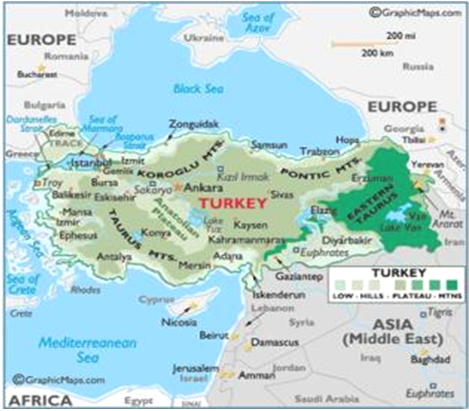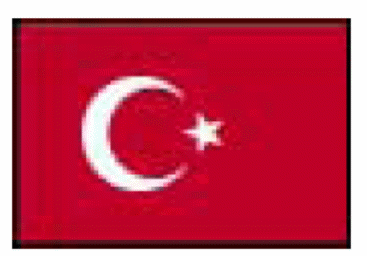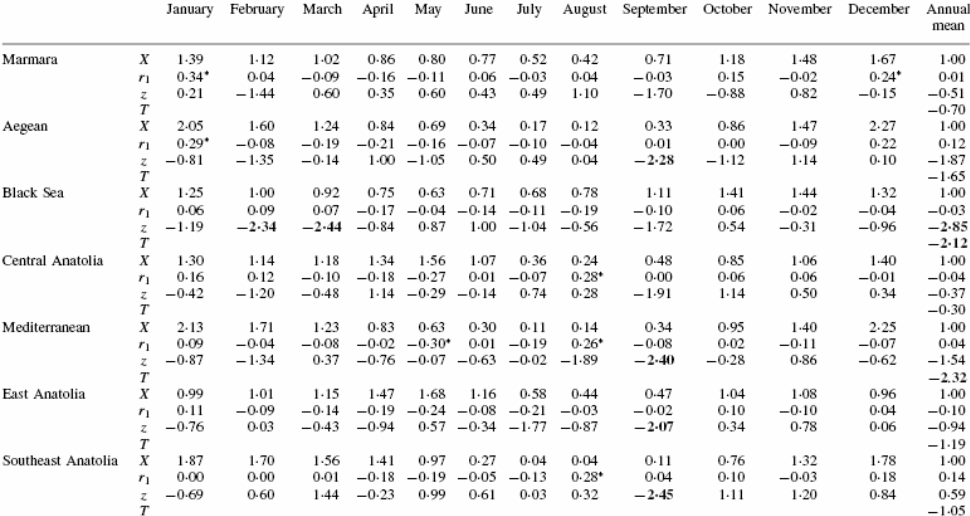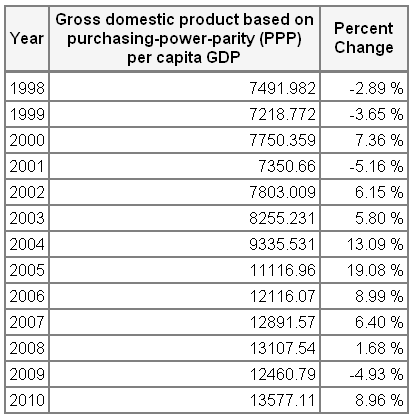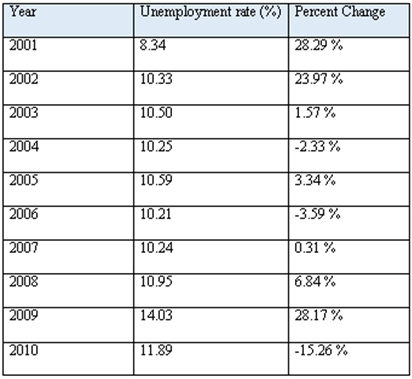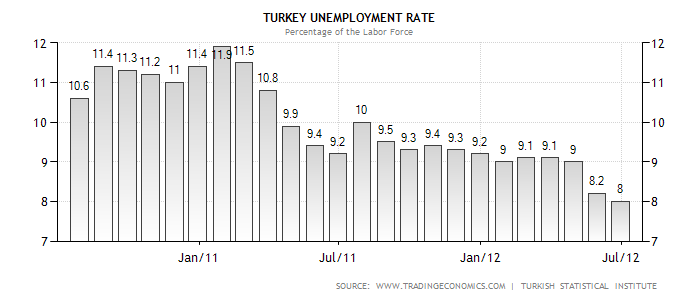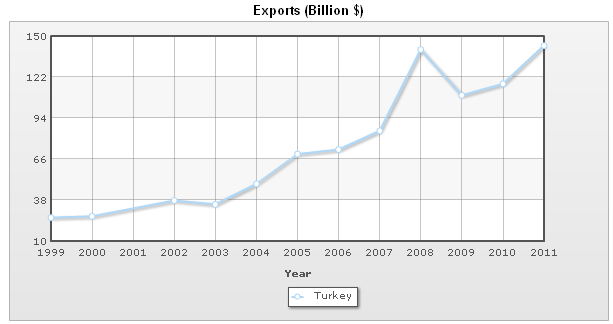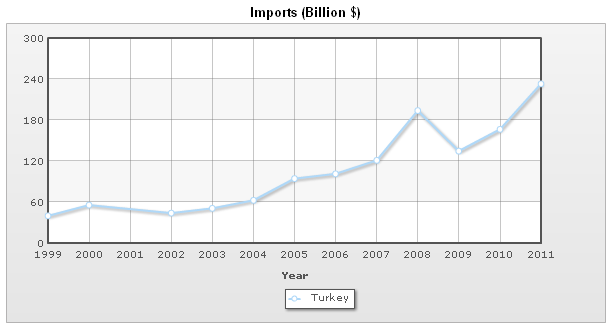Introduction
The Eurasian Country Turkey is a vital factor in the present geopolitical situation for its strategic location with its various historical events. By this time the country has engrossed the attraction of most developed countries and the people allover the world are interested to learn more about the country for their business and tourism.
This paper has aimed to present short snap of the country Turkey with deep insights of its geographical data, historical evens, political system, economical potentials, cultural heritage, and tourism prospects that would provide a better understanding for the people interested to explore their business and pleasure trip in this region.
This study would deliver with the secondary data available from the recent publications from the governmental and private resources of the most prominent authors in this area, international organizations, and their evaluations about Turkey and so on.
All the credit for this study goes to the authors of those works that assisted to organize the paper and there is nothing new, but the presentation and final conclusion delivered by the present author belongs to personal thinking and realization.
Geography – Absolute and Relative Location of Turkey
The absolute location of Turkey is exactly in the central area of the earth, linking Europe and Asia, and playing the role of a bridge between the two continents by being bounded with the Mediterranean, Aegean, and Black Sea along with the Sea of Marmara (Library of Congress, 7).
In addition, the country has boundaries with Armenia, Russia, Iraq, Syria, Greece, Bulgaria, Georgia, and Iran; geologically, the boundary between Asia and Europe is the Bosporus, a passage of water that links the Mediterranean Sea to the Black Sea, which runs exactly through the city of Istanbul; for this reason, both Istanbul and Turkey are equally in Asia and Europe.
The location map of the country in the appendix shows the exact positioning of Turkey. The capital city of the country is Ankara, and in fact, the greater part of Turkey is in Asia; however, politically, modern Turkey believes itself to be a committed European nation, and therefore it applied for membership of the EU and is already a constituent of NATO; moreover, its football-team plays in the European qualifying of WC and European trophies.
According to Library of Congress (7), when it comes to relative location, the position of Turkey is in the eastern side of Greece and the country is flanked by the Mediterranean and the Black Sea.
The Size
The country possesses an area of 780580 square-kilometers (301382 sq miles) with 9820 sq km of water and an overall coastline of 8430 km (that is 5238 miles); in addition, its territorial-boundaries are 822 km with Syria, 499 km with Iran; 352 with Iraq, 268 with Armenia, 252 with Georgia, 240 with Bulgaria, 206 with Greece, and 9 with Azerbaijan.
Being a transcontinental Eurasian nation, ninety- seven percent of Turkey engages Anatolia and the residual three percent is in Thrace; in comparison, Turkey is a little bigger than Texas, and its capital city is located in the northwest of Anatolia; conversely, it claims coastline-sovereignty extending six nautical-miles in the Aegean Sea and 12 nautical-miles in the Black and Mediterranean seas.
Turkey possesses an intricate set of marine-disputes with Greece in the Aegean Sea, as well as enduring airspace-disputes with Greeks in the same area; moreover, whilst an unresolved issue with the division of Cyprus is continuing, Syria and Iraq have also complaint about Turkey’s elimination of the headwaters of the Euphrates River, which flows from Turkey into those two nations.
According to Library of Congress report, its size is approximately half-the-size of Russia, three–tenths the size of Africa, half of South-America, slightly-bigger than China, greater-than double the size of the EU, almost equal to the state of Massachusetts, double the size of California, nearly six times as big as England and three times as big as the United Kingdom
Hydrological Features
The hydrological features of Turkey are quite complex; low-flows at rivers are of huge significance from the environmental-pollution point of view because when contamination loads, rivers reach highest drought during seasons, causing severe obscurities in evaluation of water quality standards; moreover, river secretions could have low values in some period of the year and may even be dehydrated (TNUGG 3).
This typically takes place during the summer-months while irrigation has key significance; in addition, river secretion is vital where waste water enters the river during low flow periods from the dilution viewpoint – if the flow reduces below a definite low flow value, it has an undeviating impact on the aquatic life of the surface flows under deliberation (TNUGG 3).
On a report of the Turkish hydrological processes, Partal and Ercan (1) suggested that there seemed to be a more obvious seasonal pattern in drifts of precipitation in Turkey, and the number of negative drifts surpassed the positive drifts during January, February, March, September and October; so, the utmost prevalence of negative drifts remained in late winter and September.
The table of the Turkish hydrological process (monthly to yearly mean precipitation) in the appendix illustrates the precise situation of hydrological precipitation in the country.
Orographic Features
Mountains stop Mediterranean-influences from coming into inland, giving the interior of Turkey a continental-climate with distinct-seasons; so, the Anatolian-Plateau is much more subject to extremes than the coastal-regions; particularly, winters are harsh on the plateau and the temperatures of -30°C to -40°C can occur in the mountainous regions; however, the driest regions are the Konya Ovasi and the Malatya Ovasi.
Climatic Features
People in the coastal areas observe milder climates, whilst the inland Anatolia plateau experiences hot summer and cold winter with inadequate rainfall; moreover, due to Turkey’s geological situations, it does not possess a universal or overall climatic pattern; however, in Istanbul and throughout the seashore of Marmara the climate is modest (winter-4ºC and summer-27ºC) (Library of Congress 8).
In Western Anatolia, there is a calm Mediterranean weather with standard temperatures of 9ºC in winter and 29ºC in summer; on the other hand, on the southern coast of Anatolia (Mediterranean area) the same weather can be found; however, the weather of the Anatolian Plateau is a lowland weather, with a huge temperature variation between day and night (WWCI 1 and GSS 1).
According to GSS (1), the Aegean and Mediterranean coastal areas possess yearly precipitation varying from 580 to 1,300 millimeters, and the Black Sea coastal area has the heaviest rainfall in Turkey, averaging 1,400 millimeters annually; however, the rainfall is extremely sparse in summer, but snowfall in winter is profound – annual precipitation averages 400 millimeters. The figures and graphs in the appendix illustrate the exact climatic condition of the country.
Flora and Fauna
Turkey’s flora and fauna is so rich that it became a competitor of Europe because of numerous decorative flowers like tulip and other 9,000 plant species and 8,000 animal species; some of its animals are tigers, deer, bald-ibis, and kangal-dog; conversely, Turkish people cultivate lentils, apricots, almonds, hazelnuts, and cherries as well as tulip, crocus, snowdrop, lily, etc.
History
Turkey in the Ancient Era
Aschner et al. (4) pointed out that the Anatolian peninsula which was also known as Asia Minor is the region that modern world knows as Turkey, in the ancient history the region gained two grand landmark – one is for its oldest human civilization and the other is for its connectivity between Asia and Europe.
The history of human civilization demonstrated that during 7500 BC to 5700 BC human settlements flourished in this region and the Anatolia evidenced with rise and fall of many empires that continued up to 8th century.
Inalcik (2) added that Anatolian civilization during 2500 BC, the Kingdom of Hattie flourished here that introduced the Bronze Age and named the region as Asia Minor where it evidenced both urban and rural civilization with agriculture and mining with free flow of migrants.
Its language was different from all other neighbor nations with basic characteristics of Turkic language family, with vast influence of Babylonian culture in the southern region of Anatolian, there was another indo-European language named Nesian (Inalcik 1).
The region was under tremendous attack of the Indo-European tribes, but the Hittites organized Asia Minor as a strong state by occupying Aleppo and Babylon during 1450 BC to 1200 BC, they also attacked Egyptian empire and influenced Greek with creative and cultural power; thus, Anatolia proved itself as a cradle of great civilizations.
Aschner pointed out that the Archaeological findings has demonstrated unyielding verification that the socio cultural heritage of modern Turkey has originated from the Hittite state as an archetype of the modern Asia Minor with the territorial boundaries of the Black Sea in the north, the Mediterranean Sea in south and Aegean in the west (1).
Turkey in the Middle Era
Lonsdale (129) mentioned that Alexander the Great with his modern military doctrine, sophisticated logistics system, and well trained military forces conquered Anatolia in 334 BC by descending Hellene rulers, it was not a very easy task, but has to give him high value with the sacrifice of huge trained military and took.
Next to the Alexander, the territory then absolved into the Roman Empire and prolonged up to the first century to thousand years, during their role they divided Anatolia into two parts of the Byzantine otherwise Eastern Roman Empire and the established the capital of the country in Constantinople, which is the Istanbul, the capital of modern Turkey.
The kingdom continued as one of the most dominant economic region, advanced cultural heritage, and military strength in Europe even though it slow down and turned weaker with territorial losses at the time of Roman – Persian as well as Byzantine – Arab Wars; however, Anatolia kingdom sustained until the Islamic aggression extended this region and conquered the Ottoman Empire.
Following the Byzantine–Ottoman Wars, the kingdom tried for restoration, but the Muslim aggression in 674 AD to 678 AD, the Muslim troops blockade the Byzantine capital Constantinople and ensured the fall the empowered the Muslims to rule over Ottoman Turks by extending their aggression to conquer Transoxania and Chorasan until ninths century.
In twelve century, the Mongols leader Cengiz Khan defeated the Muslim rulers and conquered Transoxania and Chorasan, due to the geopolitical importance of Turkey has gone through until the modern Turkey established with its secular and strategic alliance and successful foreign policy.
Turkey in the Modern Era
Ahmad (30) pointed out that the Ottoman dynasty had generated an inheritance in Turkey with both negative and positive impact in the political arena and there were no strong successors to restitution of the kingdom, the Young Turks ascended in the power has failed to address the people’s needs that led to evidence the constitutional movement in 1908.
At this stage, the Ottoman dynasty has attempted to manipulate and influence the heritage with radical reformation scheme and structural transformation, but Mustafa Kemal Atatürk, the revolutionary leader with his regime opposed and demanded to complete abolishing the monarchy from the country secular and democratic values.
However, the Ottoman dynasty has permitted the reformation due to the wave of nationalist movement under the leadership of Kemal, although some successors of the Ottoman dynasty like Rauf Orbay kept in the power of new government as traditional symbol and declared victory in July 1922 (Ahmad 30).
The political ideology of Kemal Atatürk was deeply influenced by secularism and his followers recognized many events of momentous significance that provided the test of real independence with numerous openness, withdrawal of all censorship, free movement of people, open market, and independence of press etc. for which people have long been eager.
Atatürk removed all discrimination based on race and color, the major religion groups’ like Muslim, Greek, Armenian, and Jewish learned and experienced a high degree of peaceful co-existence with each other (46).
Due to alliance with the Great Britain, Turkey tried to treat itself as a neutral player in the World War II, the ruling-party adopted ‘wait and see’ policy where the Berlin benefited from this neutrality, but the revolt against the axis power generated crisis in Turkey connecting its notorious Capital Tax that was lastly repealed in March 1944.
Failure to address appropriate strategy by the government bring into beginning of a new thought in the society to establish civilian leadership on the armed forces and the wave of multi party politics come into evidence instead of conservative, dictatorial autonomy of military and it given the victory of democracy over the fascism in 1945 (117).
The modern history of Turkey has unfortunate scenario of military intervention in the state power, although the people have learned to respect the military because of their sacrifice and struggle for the nation in the era of Kemal Atatürk; but modern values of democracy does not allow militaries to intervene in the decision-making and state power.
Due to Turkey’s engagement with the NATO the military expenditure were extremely raising in fifties and the government was under pressure to cut military budget while the Turkish military has no glorious role in the world war I& II, following such background of military budget cutting, the country evidenced military interventions in sixties, seventies, eighties and nineties (141).
The Political System of Turkey
Aschner et al. (10) pointed out that the membership condition of Turkey in the European Union has urged to develop the political system of Turkey including its economy and human rights condition and to do so EU suggested for enormous reformations along its legal reformation in some context.
Turkey is the first Muslim country that membership of EU, although 92% territory of the country is situated in the Asia, the country experienced at least military interventions, there are huge non-secular practice in the government has generated confusion among its people and inhabitants; thus, people demand for quick reformation.
Social progress, economic development of Turkey has deeply linked with the reformation of its political system (Migdalovitz 7).
The Political Structure of Turkey
The House of Commons (3) mentioned that under the constitution 1982, Turkey is a constitutional democratic republic with a dominance of military intervention although the recent constitutional reformation has engaged to reduce the military interference by integrating the civil society.
According to constitutional amendment of 2007, the parliament of Turkey has bannered as ‘Grand National Assembly of Turkey’ (TGNA) that consisted with 550 elected members by the direct vote of the people and they seat for four yeas in the GNAT.
There are huge number of political parties in Turkey, but the parties those get at least 55 seats are entitled to parliamentary, to avoid such dilemmas politicians go for election independently and after election they join to the favorable parties (11).
Before the constitutional amendment 2007, the two-third majority of the parliament members elected the presidents, but after that amendment president would be elected by the direct vote of the people for five years and could not be elected for more than two terms.
The power of the president has not eventually described in the constitution, but he serves as the head of legislative, executive including judicial branches, at the same time the president shares his power with the Council of Ministers represented by the Prime Minister who enjoys the power to veto any legislation along with the rights to issue emergency decrees.
President is the head of state, and though his powers are not precisely defined, they include the executive, legislative, and even judicial spheres (5). He shares executive power with the Council of Ministers headed by the Prime Minister, and has the power to veto legislation and issue emergency decrees.
The Prime Minister is empowered to appoint the most sensitive state officials like Chief Public Prosecutor, judges of the Constitutional Court and other important positions; at the same time, he acts as the chief of armed forces and chairperson of the National Security Council and accountable to the parliament.
Political Representation & Political Division
SETA (3) pointed out that the most dominant political representation of the people has evidenced by four major political parties who evidenced with their ideological heritage and the political divisions among them are very clear with the changing dynamics of Turkey where domestic and foreign policy options continuously transforming.
Following the referendum of 2010, all the political parties urged their unity to establish a new constitution for new Turkey that reflected in their election manifesto as vision of 2023 and people are likely hopeful to get a prosperous Turkey with their political representation, following are the major agenda for parties:
- The Justice and Development Party: – It is also named as ‘AK Party’ that organized in 2002 and proved itself as a most dominant political actor to change the political and social life of the people with their program and the country would be capable to overcome underlying economic crisis. The political and economic agenda of the party satisfied the people’s vision and in election of 2002, AK party ascended into the state power and continued its reformation agenda, beside the economic reform the party has aimed to maintain political stability and to ensure right and freedoms (4).
- The Republican People’s Party: – The name of the party initialized as CHP and it is the most prominent political organization of Turkey founded by Mustafa Kemal during 1923, it ideology aligned with republicanism and nationalism, under the leadership of this party Turkey entered in the modern era. Turkish major political reform, like multiparty politics, democratic values, and abolition of monarchy was the contribution of CHP. CHP has struggled for a long time against military autocracy in Turkey and bought major constitutional reforms; in the general election of 2002, it occupied 19% seats in Parliament while AK Party came to power with 34% vote.
- The Nationalist Movement Party: – The name of the party initialized as MHP that started its journey in 1969 and evidenced with influential political movements in Turkey against communism, it dominated with anti-communist sentiment of the people generated a wave of “save the country” propaganda during the cold war era and gained tremendous support from the young generation. The party has generated some ethical dilemmas in Turkey and no evidence to go to the state power; it gained 2.9% and 18% in the general election of 1987 and 1999 respectively.
- The Peace and Democracy Party: – Rather than the parliamentary seats, the significant factor of this party is to represent Kurdish political movement a different Muslim ethical group in Turkey, the party has banded by the constitutional court and reorganized as People’s Labor Party (HEP) aligning with international support, in the general election of 2011, it failed to prove its effectiveness.
Judiciary Branch
The United Nations (7) mentioned that the president appoints judges of the Constitutional Court, while the Supreme Judicial Council elects the judges of the Court of Appeals where all the judges are entitled to exercise their power independently without any bias with the aim to ensure justice and piece of the country in the light of Constitution, laws, and jurisprudence.
There is no executive power to interfere in the judiciary even in the provincial or district courts have the evidence of the independence, it is the discretion of the judges where the court would exercise its power, even the legislative and executive are loyal to the court verdicts and may not interfere to any extent.
The Supreme Judicial Council acts with the promotion, remuneration, retirement, transfer and posting of the judges that organized with judges of the Supreme Court, it monitors compliance, election, and duties in the judiciary tribunals in the country.
The Legislative Branch of Turkey
The 550 seated parliament, which named Grand National Assembly of Turkey’ (TGNA) is the highest forum to making and unmaking law, before seating in the TGNA, the members take oath to uphold the constitutional supremacy, it passes and amend any law for the greater interest of the nation, Council of Ministers are also accountable here.
The National budget, overseas treaty and agreement, war decision and all other emergence should be approved from TGNA.
National symbols of Turkey
The national flag of Turkey designed and developed with crescent moon along with ‘five-pointed star’ that has been originated from the symbols of ancient Ottoman empire while the national anthem of the ‘Independence March’ symbolized the motivational spirit introduced during liberation war in 1921.
Economics Currency
IMF (19) provided the matrix to find out the effects of macro-financial distresses on the Turkish economy and it influenced transmission channels, for example, cost of external funding jumped, imports compressed, domestic credit squeezed, elevated cost of external financing usually, raised cost of financial intermediation and indirect taxes raised, and reduced demand for Turkey’s exports.
In addition, IMF (19) mentioned that major risks mainly suffered by banking sector with EA parents, public sector, and corporate sector; therefore, IMF identified some potential risks, such as, Increased unemployment rate, created credit crunch, elevated inflation from depreciation and increased indirect taxes, decreased living standard, squeezed profits and ability to repay loans, and reduced trust on public sector. At the same time,
Exchange Rate
Until 2005 lira was very weak in relation to the US dollar, but post-2005 years lira gained enough strength, the notes of before 2008 are now out of date and the current indicative exchange rate is US $ 1 = Lira 1.81 according to the central bank data (TCMB 1).
Gross Domestic Product
According to the report of Trading Economics (1), the economic position of Turkey is much more stable than any other countries in the world because its GDP for 2011, 2010, and 2009 were $773.09 billion, $735.49 billion and $614.42 billion gradually; in addition, the GDP value of this country is approximately equivalent to 1.25% of the world economy.
In addition, Trading Economics and World Bank had considered official exchange rate of GDP, which indicates the value of all final products and services produced within a country by a fiscal year; however, Trading Economics further addressed that averaged GDP of Turkey $204.90 billion (from 1968 to 2011, GDP of this country increased from $15.80 billion to $773.09 billion).
However, GDP (official exchange rate) was near $614.42 billion, $730.32 billion, and $649.125 billion in the fiscal year 2009, 2008 and 2007 gradually; furthermore, the real growth rate has decreased surprisingly from the year 2009, for instance, the percentage (%) change rate was 29.3% in 2004, where as it was merely -15.87 % in 2009 (Indexmundi 1).
Per Capita Income
Indexmundi (1), Trading Economics (1), and IMF (25) calculated GDP on a purchasing power parity basis divided by population; however, this rate has also augmented from the last two years and it was more than $14000.0 billion in 2011 and $13577.10 billion in 2010 though it was about $12460.79 billion in 2009 (Percent Change rate was 8.96% in 2010).
However, the economy of this country was deteriorate because of global financial downturn in 2008; in addition, Indexmundi (1) reported that GDP in PPP was fluctuated from 2002 since Percent Change of GDP in PPP was 13.09% and 19.08% in 2004 and 2005 gradually while it was only 1.68% in 2008.
Since GDP in PPP shows the core economic strength of the nation, it is necessary to compare the current data with previous year’s data (from 1998 to 2010), which shows GDP is fluctuating, but national economy still good enough; however, figure (6) of the appendix illustrates these fact more elaborately.
Labor Composition
Library of Congress (15) reported that it is difficult to measure their activities of the labor force because a large portion is working in the EU and other Middle Eastern countries; in addition, Turkey’s labor force was estimated 24.74 million, 24.73 and 27.4 million in 2010, 2011 and 2012 gradually (Indexmundi 1).
At the same time, Library of Congress (15) mention that more than 41% involved with official services, 36% occupied with agricultural sectors and 23% in construction and other industry (industrial labor is seriously unionized,); however, figure five of the appendix provides the data for entire labor force of Turkey for the year 1999 to 2011.
On the other hand, the unemployment rate is higher in urban area, such as, it was 12.7% in urban area and 7.6% in 2008; however, near three million labors are members of the union to be benefited while the employers fail to follow ethical codes of international labor organization; moreover, wage disparities are immense between eastern and western Turkey.
Employment/Unemployment Rates
According to the report of IMF and Indexmundi (1), unemployment rate could measure by two ways, such as, the national with ILO harmonized definition, or the OECD harmonized definition; on the other hand, it should measure by the number of citizens actively seeking work divided by the labor power (Trading Economics 1) and Percent Change rate depend on inflows made.
Trading Economics (1) reported that present unemployment rate is near 8.0% while it was 10.8% in 2011; however, the table and figure of appendix show more information in this regard
Main Exports and Imports
Key Exports to Turkey
Indexmundi (1) stated that exporting indicates the promotion and direct sells of locally manufactured goods in a foreign market and it is a well-established and conventional form of strategy to acquiring overseas markets; so, export is one of the most important factors for Turkish economy as it earned large amount from this segment like exports income was $143.5 in 2011.
According to the Library of Congress (16) and Indexmundi (1), appliances, consumer electronics, and vehicles are the key sectors, but it exports other products and services besides these segments, such as it exports following items as well:
- Vegetable products;
- Live animals along with animal products;
- Animal or vegetable fats and oils;
- Prepared foodstuffs;
- Beverages, spirits, vinegar and tobacco;
- Mineral products and chemical;
- Plastics and rubber;
- Vehicles, aircraft, machinery, vessels and associated transport equipment;
- Miscellaneous Manufactured goods;
- Textiles and Textile Articles,
- Wood and Pulp of Wood, Footwear, Headgear, Umbrellas, Natural or Cultured Pearls, Base Metals, Mechanical Appliances;
- Optical, Photographic, Cinematographic, and so on;
Figure six of the appendix demonstrates the earning from exports in billion for the year 1999 to 2011; however, export revenue of Turkey increased from 1999, for example, in 1999 it was about $26 billion while it was more than $140 billion in 2008 though it dropped in 2009 due to financial crisis in global context.
Imports to Turkey
Library of Congress (14) stated that Turkey has to import large amount of oil and natural gas and this country imported about 1.10 billion cubic feet of natural gas (from Russia, Iran and Azerbaijan) to enhance electric power industry; Turkey increased import of gas from 25% to 58% with last seven years.
According to the report of Library of Congress (16) and Indexmundi (1) pointed out that the demand of oil has also increased by 20% from 2006 to 2010, and demand of electric power doubled in the 1990s, which was difficult for this country to keep up with demand though Turkey’s producing capacity of 35000 megawatts to 67000 megawatts exceeded by 2010. Library of Congress (16) and Indexmundi (1) pointed out also reported that
- This country imports near 90% of its oil mainly from Iran, Iraq, Russia, KSA, and Syria;
- In addition, main Items for imports are machinery, chemicals, fuels, and semi-finished goods;
- Vehicles, aircraft, vessels and related transport equipment import costs were more than $18.1 billion and $23.2 billion in the year 2010 and 2011 gradually;
- In addition, import costs for Machinery and Mechanical Appliance were about $30.2 billion and $38.14 billion in the year 2010 and 2011 gradually;
- Import costs to base metals and articles of base metal were $28.33 billion, mineral products were $6.7 billion and costs for products of the chemical or allied industries were $17.8 billion;
Figure no seven of appendix shows the expenditure for imports in billion in USD for the year 1999 to 2011; in addition, import cost of Turkey augmented from 2003 due to raise demand in domestic market, for instance, in 2003, import cost was more than $50.8 billion whereas it was over $193.9 billion and $232.90 in 2008 and 2011 gradually.
In addition, the figure no seven from IndexMundi (1) also provided more information about the expenditure related to import, such as, import costs was stable position from the year 1999 to 2004 and trade balance was negative position, but it was considerable.
Foreign Direct Investment in Turkey:
Indexmundi stated that in Turkey FDI determines the total sum of investment made by the investors of overseas countries in Turkey; however, Library of Congress (17) reported that investment policy of this country with FDI inflow was comparatively low due to political instability and the structural problem.
It is important that FDI exclude investment in the course of purchase of shares and investment commitments made by the foreign investors are also a further determinant of FDI in terms of fixed assets; however, FDI of this country was only $2 billion in 1999, but it increased slowly while it was $18.63 billion in 2011 (Indexmundi 1)
Culture and Tourism
Icoz, Ebru and Orhan (2) stated that Turkey is one of the most famous rising tourism destinations because rich geo-morphological along with tectonic multi-altitudinal structure; however, the government has already taken long-term strategic plan in order to develop the facilities for the tourists and generate more revenue from this sector.
Folklore, Music, and Dance
Turkey has very rich folkloric traditions, such as, folk music accompanies Anatolian people, and people create their own music (music pass from one another and “asiklar” or troubadours sing and play this music); in addition, Turkish folk dance is very lively and variant because regional dancing steps and rhythms are different and based on local culture and different situation;
Museums, Art Galleries, Palaces & Castles
Several important popular art galleries, palaces, and castles are:
- Ottoman museums (1839 – 1922): Ottoman museums were rooted in military collections instead of art works (Shaw 4);
- Ankara Anatolian Civilizations Museum (1464 – 1471): historically important for Turkish made up of two buildings;
- Topkapi Palace Museum (1459-1465): This museum situated in Istanbul and Mehmet II built this Palace as his principal residence along with parliament house; however, visitor would get the opportunity to see richest collections of treasures in the world including Arms and armor, Ceramics, Glass, Silverware, and so on;
- Other: Antakya Mosaic Museum, Istanbul Archaeology Museum, Ephesus Archaeology Museum and Antalya Archaeology Museum, Istanbul Museum of Turkish and Islamic Art;
- Palaces & Castles: Turkish castles and palaces have a very different look from European castles, which would give the opportunity for the tourist to experience unique
National Parks
There are 33 official national parks and 16 areas considered natural parks, such as:
- Adıyaman – Nemrut Mountain National Park: Most famous park for the huge sculptures of gods on the mountain (Ankara 1);
- Afyon – Akdağ National Park: it covers an area of 14,916 hectares and it was declared a Natural Park in June 2000;
- Other: Başkomutan Historical National Park, Soguksu National Park, Antalya – Altinbesik Cave National Park, Antalya – Bey Mountains Shore National Park, Köprülü Canyon National Park, Kurşunlu Waterfall and so on;
Gastronomy (Foods)
- Food: Turkish would like to take home-made food, some Turkish foods are the simit (ring-shaped bread), gözleme (a kind of pancake), Turkish appetizers, kebap (sometimes spelled kebab), Adana kebap, köfte (meat balls), gözleme, kumpir, and so on;
- Drinks: Tea is the national drink and it is served at breakfast; however, Turkish coffee, and alcoholic beverages are widely available;
Religion, Philosophy & Traditions
- Library of Congress (10) reported that about 99% of the total population is Muslim mainly Sunni and Islamic groups challenged the idea of the secular nation, so, the presence of the non-Muslim population declined from 2000; however, Christianity and Judaism are the other religions in practice;
Other – Temples, Festivals & Archaeological Sites
- Temples: It is some times argued that Gobekli Tepe, about 11,000 years old archaeological site, was the world’s first temple; among other temples, Temple of Artemis and Didyma are significant; besides, there are numerous other active temples too;
- Festivals: Apart from New Year, Eid, and Christmas, International-Film-Festival, Mevlana-Memorial-Celebrations, Folklore-Festival, Children’s-Festival, Nasreddin-Hodja-festival, Izmir-international-fair, etc. are significant
- Archaeological Sites: Ephesus, Aphrodisias, Hierapolis, Pergamum, Gobekli, Priene, Patara, Arykanda, Olympos, Termessos, and Sagalassos, are the major archaeological sites of the country
Conclusion
This study demonstrated that Turkey is a resourceful country with its geopolitical importance, glorious historical heritage, ancient civilization, and cultural development, stable economic and political progress those enabled the first Asian country to be the member of European Union. The rich legacy of modern Turkey would catch the attention of foreigners for business and tourism.
Works Cited
Ahmad, Feroz. The making of modern Turkey. London: Routledge, 2003. Print.
Ankara, Gazi. Turkey National Parks. 2012. Web.
Aschner, Diana. et al. 2009. History & Culture of Turkey: From Anatolian Civilization to Modern Republic. Web.
GSS. 2012. Hunting in Turkey for Bezoar Ibex, Anatolian Chamois and Anatolian Red Deer. Web.
Icoz, Onur. Ebru Gunlu and Orhan Icoz. 2008. The Role of Travel Intermediaries in the Development of Mountain Tourism With Respect To Sustainable Mountain Tourism Policies: A Case Of Turkey. Web.
IMF. 2011. IMF Country Report. Web.
Inalcik, Halil. 2012. Turkey And Europe: A Historical Perspective. Web.
Indexmundi. Country profile 2012 of Turkey. 2012. Web.
Library of Congress. 2008. Country Profile: Turkey. Web.
Lonsdale, David. 2007. Alexander the Great Lessons in strategy. Web.
Migdalovitz, Carol. 2010. Turkey: Politics of Identity and Power. Web.
Partal, Turgay & Ercan Kahya. 2005. Trend analysis in Turkish precipitation data. Web.
SETA. 2011. Political Parties In Turkey: From 2010 Referendum To 2011 June Elections. Web.
Shaw, Wendy. 2011. National Museums in the Republic of Turkey: Palimpsests within a Centralized State. Web.
TCMB. Central Bank of the Republic of Turkey Exchange Rates. 2012. Web.
The House of Commons. 2008. Turkey Today. Web.
The United Nations. 2004. Republic of Turkey: Public Administration Country Profile. Web.
TNUGG. 2007. The Report of Turkish National Hydrology Commission. Web.
Trading Economics. Turkey Unemployment Rate. 2012. Web.
WWCI. 2011. Average weather in Side, Turkey. Web.
Appendices
